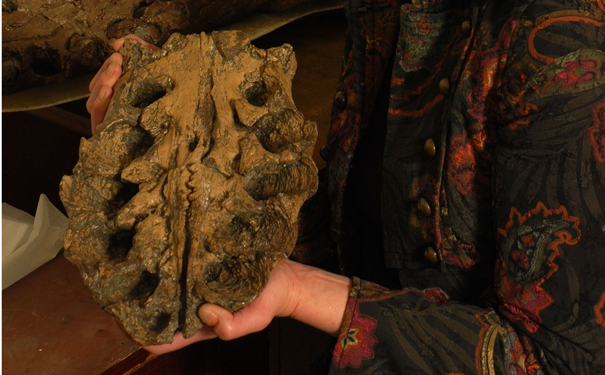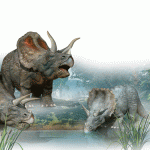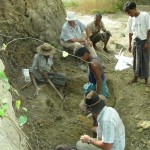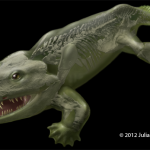
Dr Judyth Sassoon holding part of the snout of the Westbury pliosaur. The holes on the specimen are tooth sockets. Credit: Simon Powell
Joint pain may be an age-old affair.
Arthritis has been prominent since the beginning of civilisation, making it one of the oldest diseases in the world. Dr Judyth Sassoon from the University of Bristol suggests that the disease may have even affected Mesozoic reptiles.
The eight-metre-long pliosaur was an ambush and pursuit predator, armed with huge jaws and 20-centimetre-long teeth that would have allowed it to rip other reptiles to pieces. But the individual examined by Sassoon was the victim of an arthritis-like disease that would have eventually prevented it from hunting.
She noticed that the individual had the signs of a degenerative condition, similar to human arthritis, which had eroded its left jaw joint. “This is clearly indicated by tooth marks from the upper jaw impinging on the bone of the lower jaw and, similarly, a tooth from the lower jaw causing an infection in the tooth socket of the upper jaw,” she says.
The pliosaur, which has been tentatively identified as an elderly female, managed to survive with her disability for some time. The erosion marks on its jaw, created by its teeth, suggest that it was a prolonged misalignment and that the pliosaur would have been able to feed despite the disease.
Pliosaurs were at the top of their food chain, so the disorder would not have made this individual vulnerable to predators, except perhaps another pliosaur. Sassoon is surprised that other pliosaurs did not take advantage of her weakened state.
“One would expect such deadly predators to hunt weakened specimens of their own kind,” she says. “Perhaps the sheer size of our specimen put the others off.”
However, her feeding habits may have led to her eventual demise. Pliosaurs may have fed like modern day crocodiles, dismembering their prey by twisting and thrashing in the water, which would have placed enormous pressure on their jaws.
An unhealed fracture suggests that the jaw broke towards the end of the pliosaur’s life and prevented her from feeding altogether. “I would speculate that a pliosaur with a weak jaw might prefer to scavenge rather than hunt, but perhaps our specimen miscalculated with its last meal and attempted to take a vigorous prey item, which struggled and broke the pliosaur’s already weakened jaw,” Sassoon says.
Dinosaurs, ancient crocodiles and other Mesozoic reptiles may also have been affected by this condition, as diseases in one branch of the reptile family could also occur in another branch. A crocodile living in a Safari Park near Birmingham also suffers from a deviated lower jaw, similar to that of the pliosaur.
“It is alive, somewhat bad-tempered, but clearly able to survive and feed with its condition,” Sassoon explains. However, it is not yet known if the cause of the jaw deviation were the same in these specimens. ““By Laura Boness and Alice Orszulok






